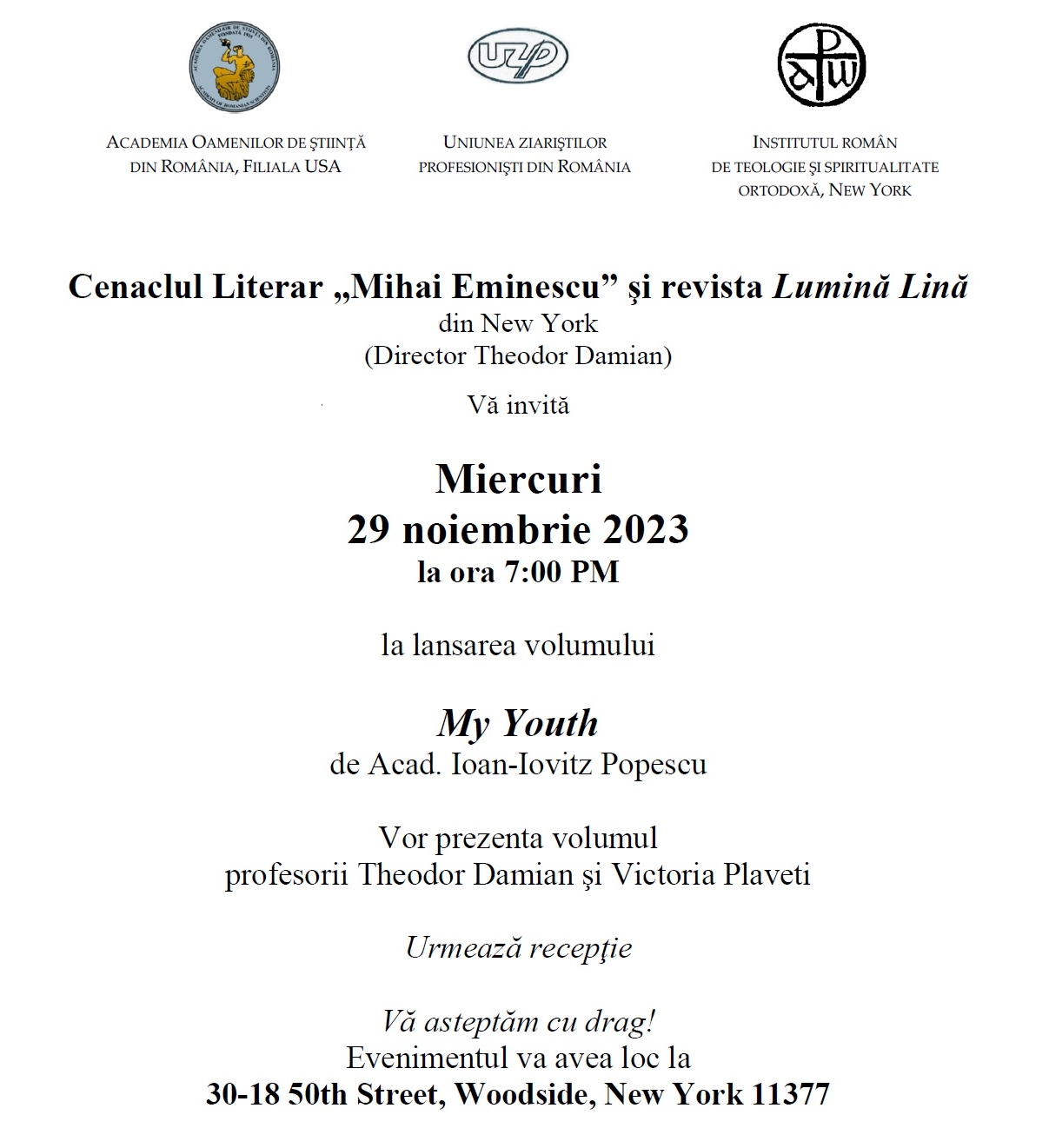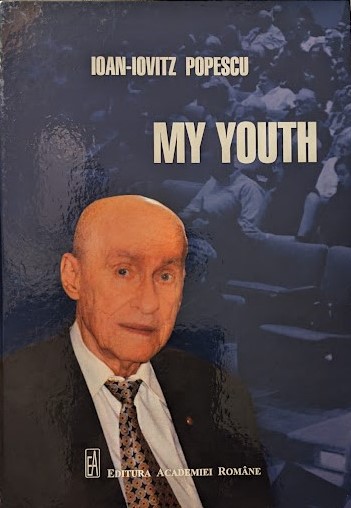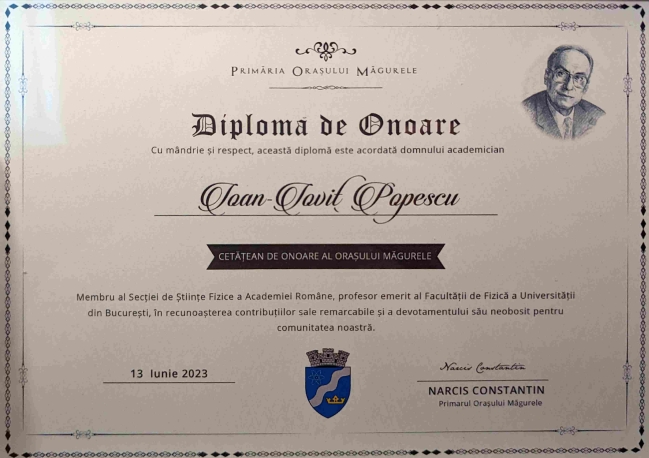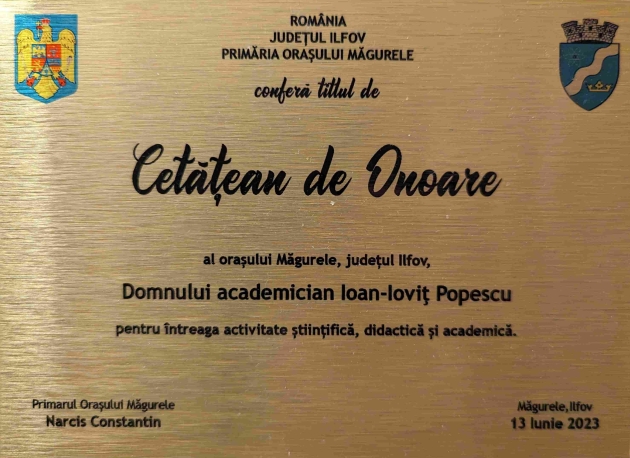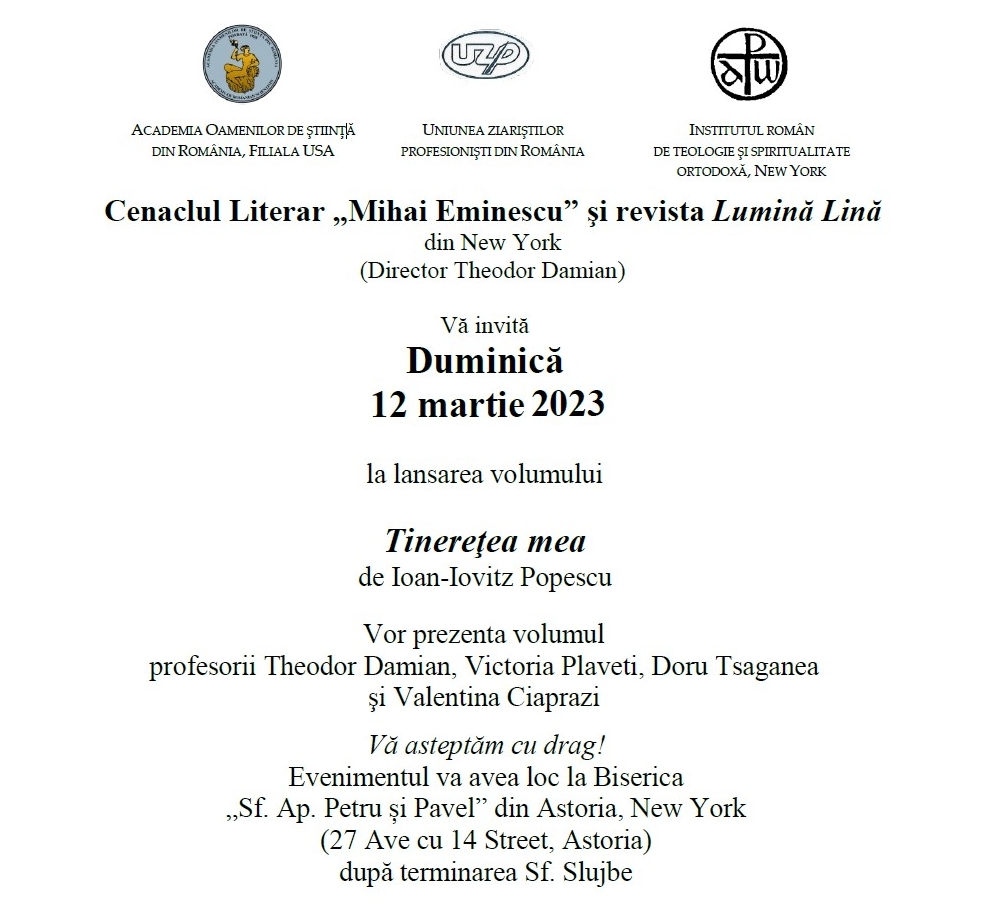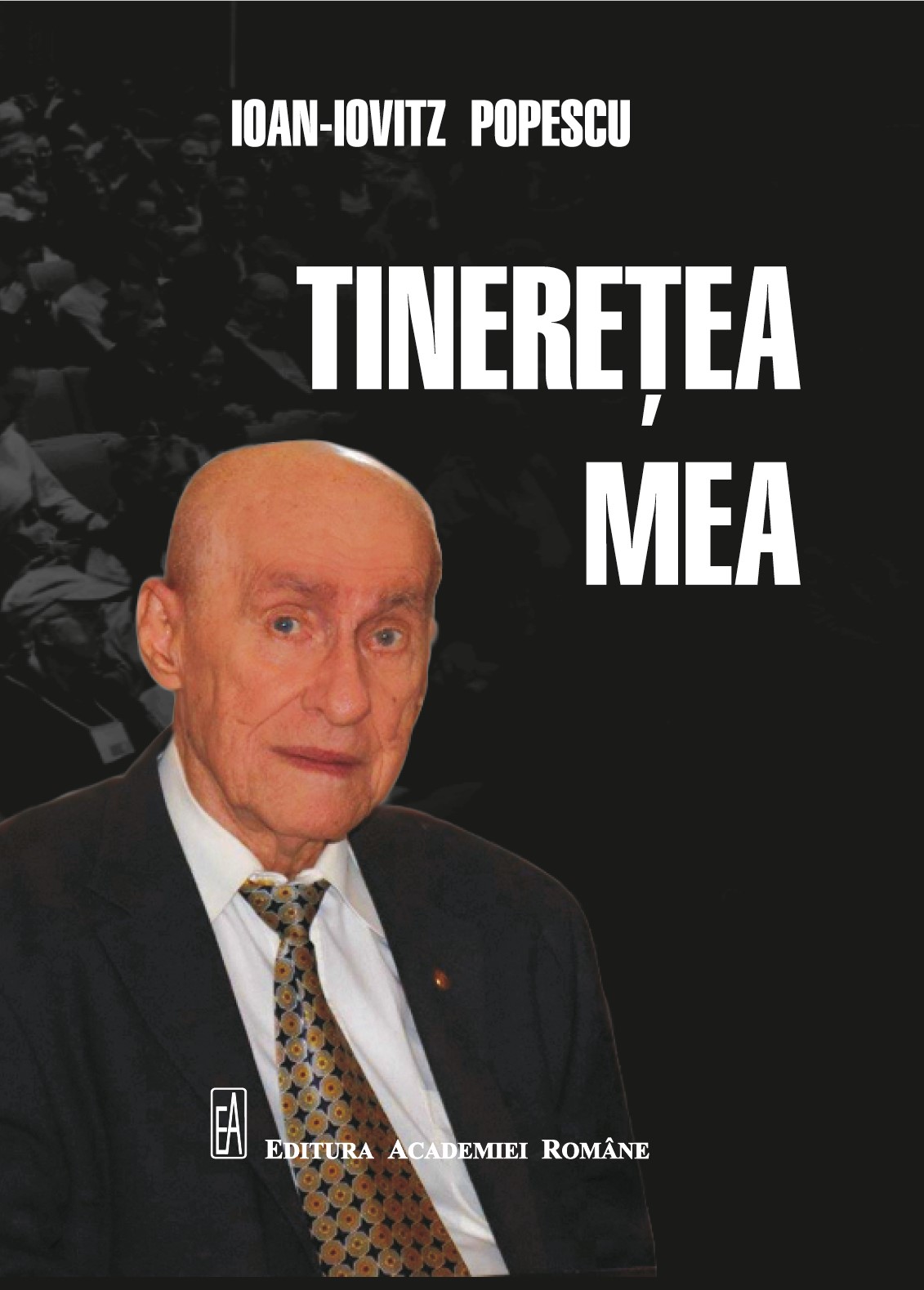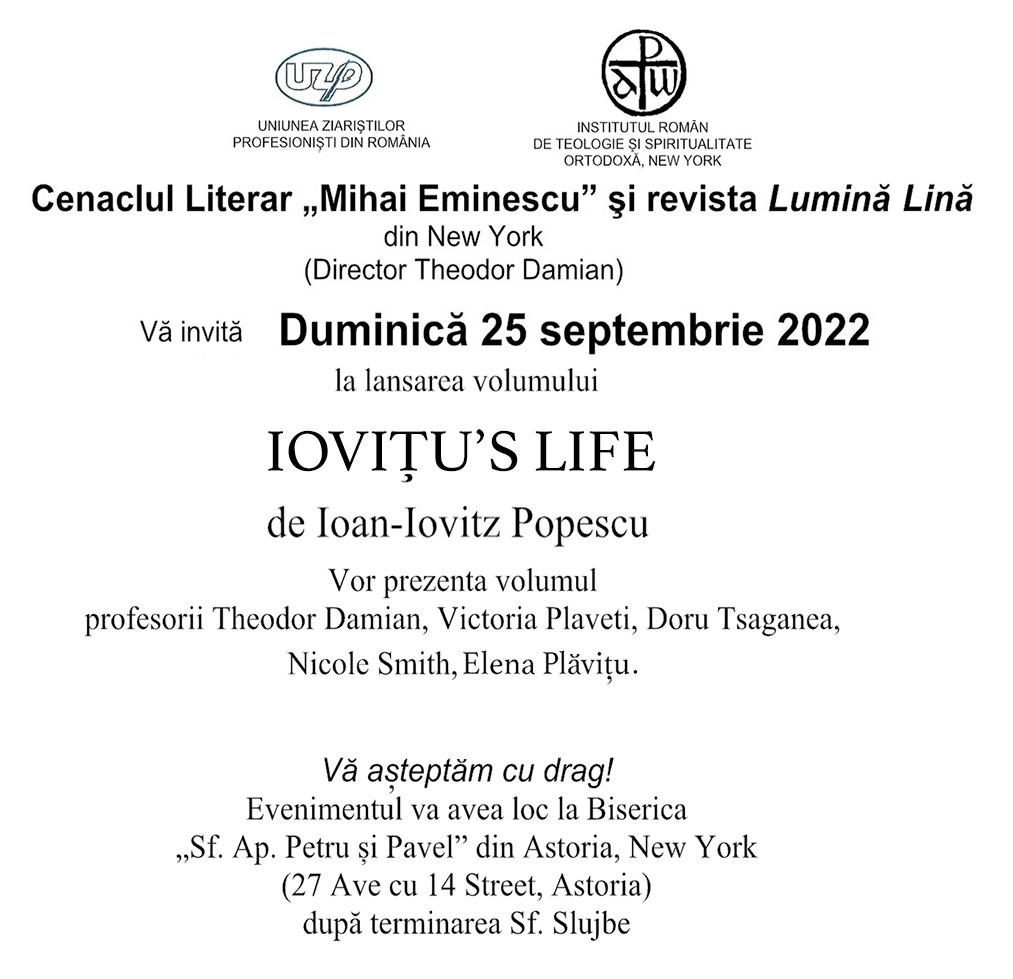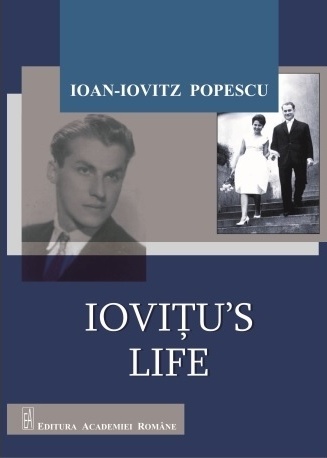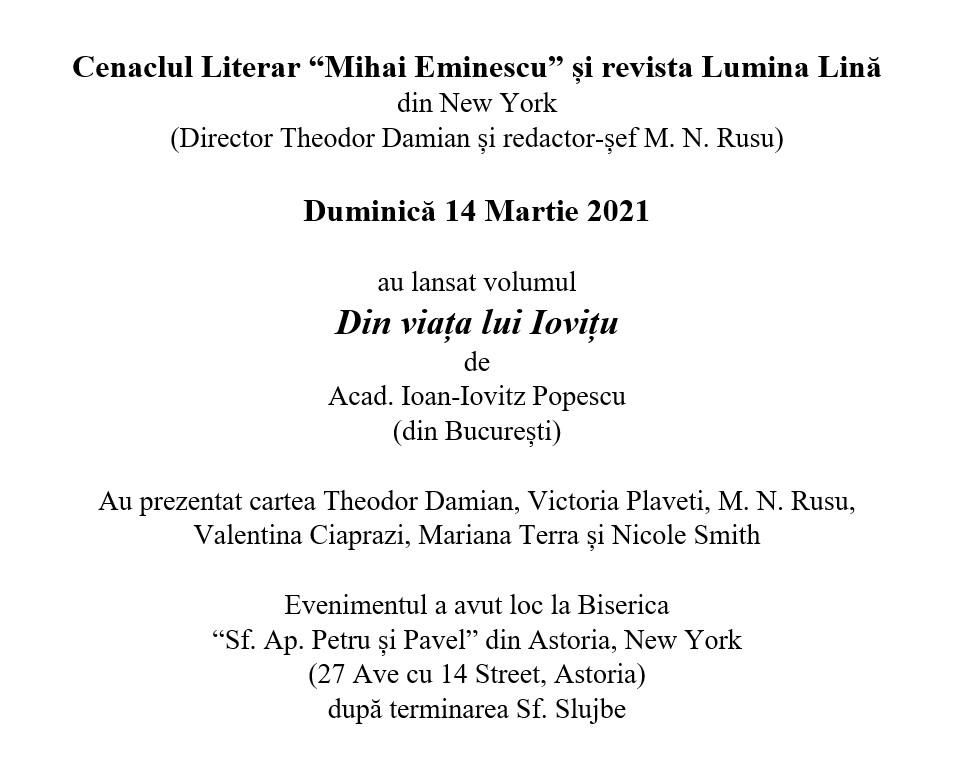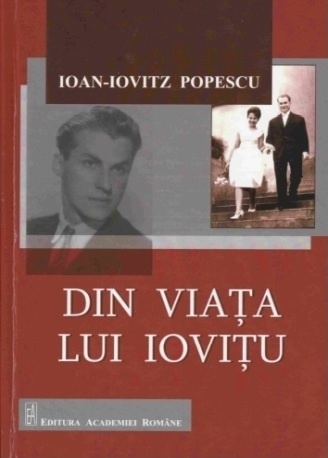Member of the Romanian Academy
Ioan-Iovitz Popescu - Wikipedia Iovitzu’s Google Scholar profile
The release of the book "My Youth" - see on YouTube
Popescu, Ioan-Iovitz, Iovițu's Life, Editura Academiei Române, Bucureşti, 2023, ISBN 978-973-27-3789-7
Scrisoare aniversară din partea Preşedintelui Academiei Române (1 octombrie 2023; PDF)
Birthday wishes from the President of the Romanian Academy (October 1, 2023; PDF)
Acordarea diplomei "Cetățean de onoare al Oraşului Măgurele" (13 iunie 2023; PDF)
Recipient of the diploma "Honorary Citizen of the City of Măgurele" (June 13, 2023; PDF)
Vedeți pe YouTube - Movie by Andrei Țugulea
Lansarea cărții "Tinerețea mea" - vedeți pe YouTube
Popescu, Ioan-Iovitz, Tinerețea mea, Editura Academiei Române, Bucureşti, 2023, ISBN 978-973-27-3648-7
Prezentarea cărții "Tinerețea mea" de către Dr. Victoria Plaveti (2023; gate io)
The release of the book "Iovițu's Life" - see on YouTube
Popescu, Ioan-Iovitz, Iovițu's Life, Editura Academiei Române, Bucureşti, 2022, ISBN 978-973-27-3516-9
Lansarea cărții „Din viața lui Iovițu” - vedeți pe YouTube
Popescu, Ioan-Iovitz, Din viața lui Iovițu, Editura Academiei Române, Bucureşti, 2020, ISBN 978-973-27-3261-8
Omagiu adus Academicianului IOAN-IOVITZ POPESCU, la New York (24 martie 2021; PDF)
Sesiunea aniversară a Academiei Române "Academician Ioan-Ioviț Popescu - 90 de ani" (2022; JPG)
Invitație (PDF) - Afiş (PDF) - Mesajul Presedintelui Academiei Române (PDF) - Galerie foto la Academia Română
Iovitzu la 90 de ani, prezentat de Dr. George Dinescu (PDF) - Iovitzu at 90 - Movie by Andrei Țugulea (see on YouTube)
Comunicat al Academiei Române despre Sesiunea aniversară dedicată Acad. Ioan-Iovitz Popescu la 85 de ani (2017; JPG)
Invitație (PDF) - Gabriel Altmann's message on this occasion (PDF)
Thanks for the speakers at my 85th anniversary (PDF) - Galerie foto la Academia Română
Romanian Reports in Physics Festschrift to Honor Iovitzu on his 80th Anniversary (2012)
Iovitzu at 80 as Seen by Dr. George Dinescu (PDF) - Ioan-Iovitz Popescu at his 80th anniversary, by Gabriel Altmann (PDF)
Iovitzu at 80 - Movie by Andrei Țugulea (see on YouTube; PDF) - Galerie foto la Biblioteca Națională de Fizică
Opera Omnia 2009 Prize (May 4, 2009; PDF)
Romanian Reports in Physics Honors Professor Ioan-Iovitz Popescu on his 75th Anniversary (2008)
Iovitzu Seen by Nicholas Ionescu-Pallas (PDF) - On the Symbiosis of Physicists and Linguists - Gabriel Altmann (PDF)
Life and Scientific Works of Ioan-Iovitz Popescu at the 75 year anniversary - Silviu Olariu (PDF)
Vita et Opera: Physics, Plasmas & Lasers
Gaz Ionisés. Décharges Électriques dans les Gaz (Dunod, Paris, 1958, 336 pages; PDF)
Geometrical Optics (Contemporary Literature Press, 2017; PDF)
Ether and Etherons. A Possible Reappraisal of the Concept of Ether. (Contemporary Literature Press, 1982; PDF)
Leisure: Linguistic Opus
Altmann Quantitative Linguistics Analyzer (AQLA)
This tool is aimed for easy calculation of quantitative linguistics indicators of a given piece of text.
Radu Vasilescu, the author of the AQLA program, used the formulas given in the publications of Gabriel Altmann and Ioan-Iovitz Popescu.
Newest Publication: Vocabulary Richness in English Poetry - The Lambda Indicator and Beyond
G. Altmann's Bibliography (PDF)
Quantitative Analysis of Poetic Texts (De Gruyter Mouton, 2015) Word Frequency Studies (De Gruyter Mouton, 2009)
The Lambda-structure of Texts (Studies in Quantitative Linguistics 10, RAM-Verlag, January 2011; PDF)
Quantitative Analysis of Italian Texts (RAM-Verlag, February, 2010; PDF) Vectors and codes of text (RAM-Verlag, July, 2010; PDF)
Popescu, I.-I., Mačutek, J., Altmann, G. (2009). Aspects of Word Frequencies. Studies in Quantitative Linguistics 3, IV + 198, RAM-Verlag; (PDF)
Sandulescu, C.G., Vianu, L., Popescu, I.-I., Wilson, A., Knight, R., Altmann, G. (2015). Quantifying Joyce's Finnegans Wake. Glottometrics 30, 45-72 (PDF)
Popescu, I.-I., Altmann, G. (2014). The lambda structure of language levels. Glottometrics 27, 54-88 (PDF)
Popescu, I.-I., Zörnig P., Altmann, G. (2013). Arc length, vocabulary richness and text size. Glottometrics 25, 43-53 (PDF)
Popescu, I.-I., Mačutek, J., Altmann, G. (2008). Word frequency and arc length. Glottometrics 17, 18-42 (PDF)
Zipf's law – another view (Quality and Quantity, 44(4), 713-731, 2010)
Links dedicated to my dearly beloved Denisa (Daisy):
Heralding Laser Spectroscopy - Vita et Opera of Dr. Denisa Popescu (2003)
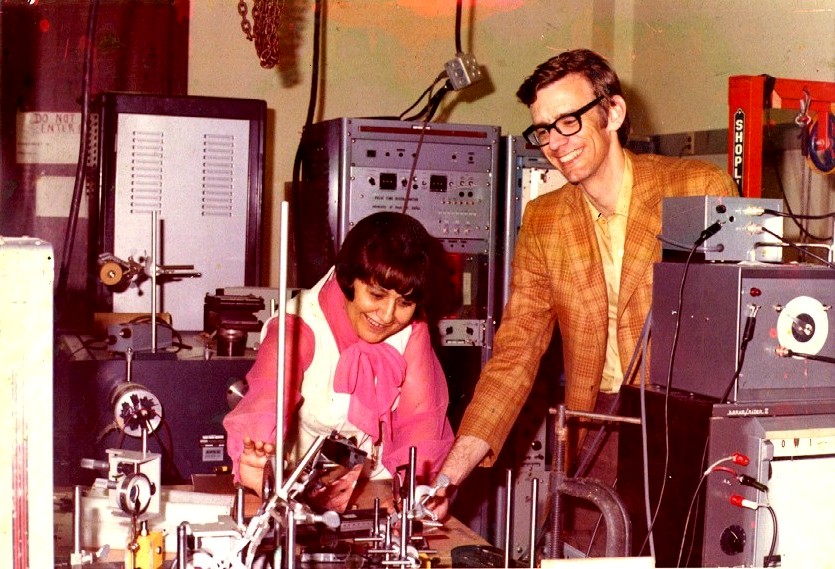
Denisa at the time of discovering multiphoton spectra (Spring of 1973)
Dr. Denisa Popescu - In Memoriam by Carl B. Collins (November 27, 2003)
Nominated for the Nobel Prize in Physics (1981, 1995, 1996, 1997) for her discovery of atomic multiphoton spectra (paper received April 16, 1973),
Denisa's seminal paper (published March 1, 1974; PDF) is cited as a first reference in the review article from Physics Reports 429 (2006) 123-241 (PDF).
Pictures of Denisa at her apogee:
Our wedding (August 10, 1963)
Her look while discovering multiphoton spectra (1973)
With Professor Carl B. Collins, Center for Quantum Electronics, UT Dallas (1973)
Working out spectral records (1973)
Denisa and her Dallas team (1973)
Beloved, sleep: “Weep not, she is not dead but sleepeth” Luke 8:52 (November 2004)
Denisa & Iovitzu - Photo Album (April 2006)
Days of September 2007
Damned impact factors
Denisa în culmea gloriei - transcriere de pe CD (March 1973; PDF)
Aşa am întâlnit-o pe Denisa (April 2023)
Iovitzu's Author Profile page at the National Physics Library in Magurele - nipne.ro (PDF)
Links to other major achievements:
First experimental evidence of nano-clustering (1968; PDF)
First experimental evidence of multiphoton spectra (1973; PDF)
My most cited paper, with Silviu Olariu: The quantum effects of electromagnetic fluxes Rev. Mod. Phys. 57, 339 - 436 (1985; PDF),
recently quoted in the review paper: Topological Metamaterials ArXiv.org 2211:10006 (2022; PDF)
Early proposal of X-ray pumping of gamma ray lasers (1999; PDF)
Accelerated Emmission of Gamma Rays from the 31-yr Isomer of 178 Hf Induced by X-Ray Irradiation (1982; PDF)
and recent Triggered Isomer Proof confirmation (2008; PDF)
Hafnium controversy - Wikipedia
Iovitzu's Curriculum Vitae contents:
Summary - More detail - Supervised Ph.D. dissertations
List of scientific work - Books - Foreign International Journals
Romanian Academy Journals - International Conference Proceedings
Especial Topics:
In Magistri Badareu Memoriam - The Works and the School of Eugen Badareu
Assisting the Birth of Optogalvanic and Laser Spectroscopy - Nineteen selected articles that we published on this topic (1969-1991)
Assisting the Birth of the Gamma-Ray Laser - Thirty selected articles we published on this topic (1979-2004)
Citations by Nobel Laureates: Bloembergen, Lamb, Prokhorov, Schawlow, Yang
Short Citation List - Short Title of Citing Paper and First Author Only. Cited Papers Ranked by Descending Citation Frequency
Complete Citation List - Complete Title of Citing Paper and Full Authorship
Journal Ranking by Average Impact Factors (updated December 2002)
On a Zipf's Law Extension to Impact Factors (2003)
Ether and Etherons (PDF) - Translated from the Romanian Academy journal "Stud. Cercet. Fiz.", vol. 34, 451-468 (1982)
Sub-Quantum Medium and Fundamental Particles (2005)
"The last word" in gravity
From: Ioan-Iovitz Popescu
Abstract
To: Nobel Prize in Physics - Winners in 2017, kipst@icloud.com and barish@ligo.caltech.edu; also jeandeclimont@yahoo.ca
& other 327 potentially interested people
Date: Jan 20, 2022, 10:55 PM
Subject: "The last word" in gravity
Distinguished Confreres,
As you can see, I have few ideas, but fixed ones. In my humble opinion, "the last word" in gravity was had by my late friend Nicolae Ionescu-Pallas (1932 - 2017) in his thorough article
Reflections Concerning the Genuine Origin of Gravity (2003, PDF).
The greatest honor of my life is the citation of the etherons on pages 14-15 of this historical article.
With the best thoughts and wishes for Good Health,
Acad. Ioan-Iovitz Popescu - iipopescu
Attachment:
Reconstruction of Einstein's Works on November 1915, Regarding the Gravitational Field Equations and the Prediction of the Gravitational Tests (2005, PDF)
by Nicholas Ionescu-Pallas*, Ioan-Iovitz Popescu** and Rudolf-Emil Nistor***
* Institute of Atomic Physics, Bucharest, Member of the General Relativity and Gravitation Society
** Member of the Romanian Academy
*** Physics Department, Politehnica University, Bucharest
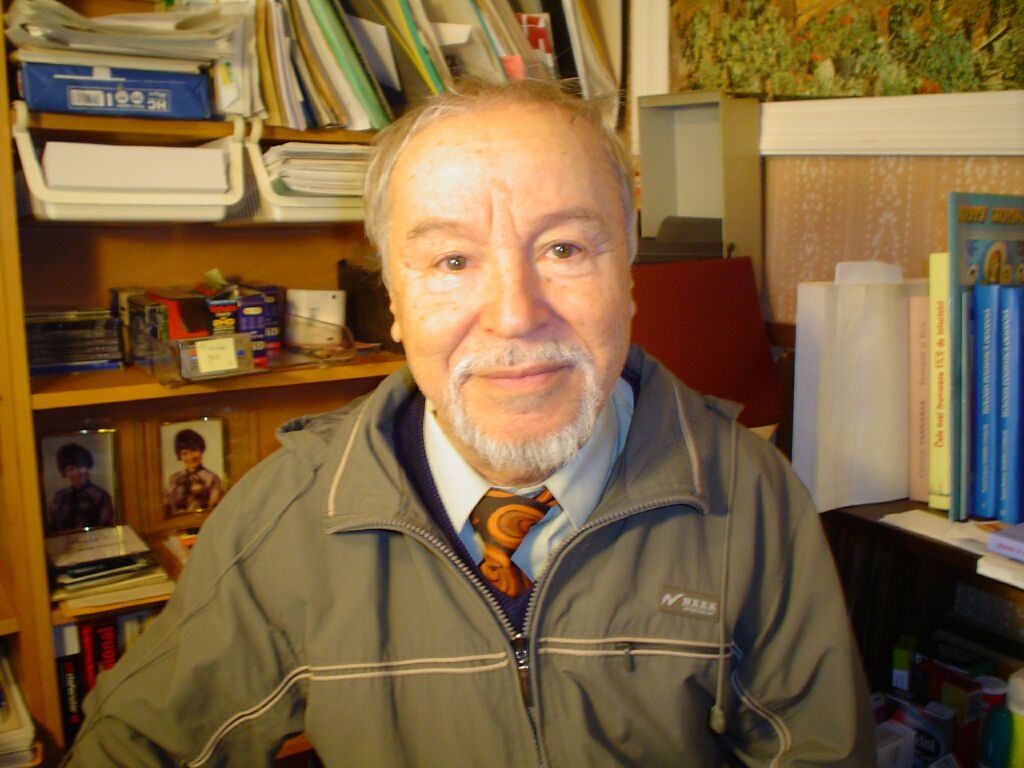
Nicholas Ionescu-Pallas (Măgurele, Bucharest, 2005)
List of Scentific Papers (PDF)
During the years 1912-1918, the creative efforts of Albert Einstein (b. 1879 - d. 1955) were directed towards the discovery of General Relativity Theory, name under which he meant a comprehensive theory of gravito-dynamic phenomena, including principia,
mathematical equations, interconnections between space, time and matter and physical implications at all scales of matter aggregation. Out of this relatively large period of scientific activity, we focused our attention to a much more restrictive period,
namely the week since 18th to 25th November 1915, when the efforts of Einstein were for the first time successfully materialized in mathematical equations never infringed since that time on. The purpose of this paper is that to reconstitute the demonstrations
left aside, for the sake of graphical space economy, in the two works published by Einstein on 18th and 25th November 1915 in Sitzungsberichte (Berlin). So, we hope to enlighten to a greater extent the line of reasoning which led to one of the outstanding
discovery of XX-th century - the General Relativity Theory. At the same time, a historical explanation, concerning the priority of Einstein referred to other competitors, is given now, when a centennial celebration of another famous Einstein's discovery -
the Special Theory of Relativity - does happen.
Conclusions
The two papers of Albert Einstein dated 18th and 25th November 1915 highlight a key moment for the thoughts that eventually led to the discovery of the General Relativity as a viable theory of the dynamic gravitational phenomena. Published in a lapidary form,
apparently sparing graphical space, the two articles, the first with the three relativistic tests of the gravity and the second establishing the field equations, appeared in a crucial moment of crisis, when the efforts to create the gravito-dynamics based on
the restricted relativity failed and the only chance was Einstein's "General Relativity". In 1914, Einstein did not know yet how he will couple the gravitational field to its sources, but in the late fall of 1915, the necessary clarification occurred to him. The
equivalence principle works in the space free of sources, where the curvature scalar is zero, together with the scalar of the matter tensor. The solutions of the field in this domain should be prolonged up to the source zone where the two scalars differ from
zero inasmuch as to fulfill the following purposes: (i) to result a linear relation between the tensors Rμν, Tμν and gTμν or (equivalently) between the tensors Tμν , Rμν and
gRμν and (ii) to recover, in the non-relativistic case, the Poisson equation. In the epoch of working out the general relativity, Einstein was so much concerned with the equality of various types of motion inasmuch as he was conducted to contest
the role of the inertia principle (and the corresponding Poincaré transformation group) in the enlightenment of physical theories and avoided to use the inertial frame of the observer. But precisely in this reference frame it is possible to define the
mechanical Lagrangean L=-m0cdS/dt , as well as the concept of "gravitational refractive index", standing at the ground of the discovery of the 4th test of the general relativity theory by Irving Shapiro in 1961, namely "the retardation of a
radar signal caused by passing through an intense gravitational field". However, we have to point out the fact that Einstein's attitude regarding the inertia principle changed since 1938 when, working with Hoffmann and Infeld in the many-body gravitational problem,
he has been obliged to admit that the mass center moves inertially. In the controversy about the existence of black holes with finite spatial extension, Einstein adopted, likewise Schwarzschild, a negative position (that is that there exist only punctual black
holes surrounded by a horizon with constant area S=16πμ2, as a result of a strong deviation of the geometric manyfold from the Euclidean geometry at inter-particle distances of the order of magnitude μ=GM/c2). In the whole Einsteinean
thinking, one may remark a priority of the intuition based on observation and experiment, in contrast to pure mathematical speculations, which should be subjected to a lucid control. We believe that the reconstruction of the two papers dated on November 1915, with
details, thus allowing to young scientists to follow Einstein's deep physical thinking line, is most useful and instructive.
Other Physics Links:
A Schrödinger type explanation of Fresnel formulas (2007, PDF)
On the energy transfer in an optical coupler (2007, PDF)
Contact: iovitzu@gmail.com
Web site: http://www.iipopescu.com
